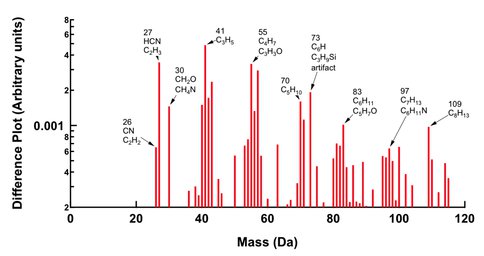2011 Annual Science Report
 NASA Jet Propulsion Laboratory - Titan
Reporting | SEP 2010 – AUG 2011
NASA Jet Propulsion Laboratory - Titan
Reporting | SEP 2010 – AUG 2011
Task 2.2.1 Characterization of Aerosol Nucleation and Growth
Project Summary
A quantitative understanding of the particle formation and growth in the Titan atmosphere is still unrealized. Laboratory work is being conducted to clarify these processes.
Project Progress
Co-Investigator Richard Flagan and Graduate Student Xerxes Lopez-Yglesias seek to elucidate the mechanisms for and develop a quantitative understanding of particle formation and growth in the Titan atmosphere.
The primary mechanism of new particle formation in the Titan atmosphere is unlikely to be homogeneous nucleation of supersaturated vapors. Instead, chemical nucleation of tholins, as well as heteromolecular, possibly ion-mediated nucleation lower the supersaturation required to form new particles, as illustrated in Figure 1. With multiple mechanisms of new particle formation possible, the key to understanding the Titan haze and cloud properties becomes the condensation processes in the complex, organic rich environment of Titan. The focus of this task has, therefore, shifted to these growth processes, and the experimental apparatus is being modified to accommodate experimental probing of cloud condensation nucleus (CCN) activation and growth under Titan atmospheric conditions.
A source of cloud condensation nuclei is required to study particle growth processes in the laboratory. A microplasma reactor has been constructed to act as a source for tholin-like particles in our experiments. Illustrated in Figure 2a, the microplasma reactor employs an atmospheric pressure, hollow cathode discharge in a 180 μm diameter tube. The particles produced with this reactor are small, about 2-3 nm diameter, as shown in Figure 2b. The composition of the product particles, determined using an Aerodyne Research, Inc., Aerosol Mass Spectrometer (AMS), shown in Figure 3, is similar to that reported by Waite et al. (2005) for the ion-neutral mass spectrometer data obtained in a Titan flyby.
The formation, growth, and charging of Titan haze particles are affected by their charge state, as is the measurement of particle growth in laboratory simulations through differential mobility analysis. We have reexamined the theory of aerosol particle charging, and identified a number of assumptions and computational limitations of the earlier theory that strongly affect the ultimate charge distribution, particularly for large particles, which will impact estimations of the electric field and charge distribution in the Titan atmosphere. The theoretical developments further revealed enhancements to the condensation flux to free-molecular and transition regime particles that have been neglected in most studies of aerosol condensational growth. Preliminary estimates indicate that these enhancements are large in the upper atmosphere of Titan.
Figure 1. Schematic illustration of the processes involved in new particle formation in the Titan atmosphere. Cosmic rays produce the gas ions that contribute to nucleation.
Figure 2. Microplasma reactor used to produce tholin-like nanoparticles. (a) Schematic diagram. (b) Particle size distribution measured using a nano radial differential mobility analyzer (Brunelli et al., 2009).
Figure 3. AMS mass spectrum of nanoparticles produced with the microplasma reactor.
-
PROJECT INVESTIGATORS:
-
RELATED OBJECTIVES:
Objective 1.1
Formation and evolution of habitable planets.
Objective 2.2
Outer Solar System exploration
Objective 3.1
Sources of prebiotic materials and catalysts


